Loch flies
{{start}}
Loch Style fly-fishing involves fly-fishing from a boat, side onto the wind, using a system incorporating one or a number of flies. There are both wet and dry lock style fishing techniques. There are four distinct sub sections of loch flies: wake or bob flies, dropper flies that can be placed in various position s in a team of flies for different effects, attractor flies which are generally fished on a middle dropper and point flies.
The dry fly technique involves casting out in the direction of the drift, stopping the cast above the water so as to let the team of flies settle, waiting the desired time (often only 5 to 10 seconds) and then repeating the process in a slightly different position. Dry fly Loch style fly fishing covers a lot of water in a short time. The flies used are ordinary dry flies such as those shown in the dry fly page of this website. When selecting a team of flies try to balance the selection so that the most aerodynamic fly is on the point and the least aerodynamic fly is on the top dropper.
The wet technique involves casting out in the direction of the drift, fishing the flies using a range of techniques. Wet fly loch fly fishing, as well as incorporating a range of different retrieves and fly lines ranging from floating right through to very fast sinking lines can also involve fishing: the drop, the retrieve, the stop, the lift, the hang and the dibble and the dapple.
{{end}}
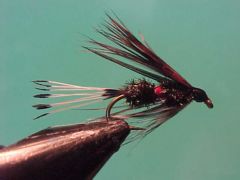
{{+1}}Royal coachman wet – Chatto’s version{{-1}}
{{start}}
One of the first wet flies tied was the coachman and that consisted of just a black body and a a set of white hackle slip wings. Over time flies have evolved and one path the coachman took was the substitution of a "royal" body for the simple black body. Many versions have been tied since and this one works for me.{{end}}

{{+1}}Mallard and claret – Chatto’s soft hackle version{{-1}}
{{start}}
One of the first loch flies I was introduced was a mallard and claret tied in a traditional way with a pair of feather slip wings. I thought it was the bees knees as a bob fly and used it any time when mayflies were around. For me this is a vastly superior fly and as well as being a great substitute for a traditionally tied mallard and claret also works well on mayfly feeders taking pre emergers.{{end}}
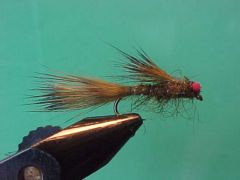
{{+1}}Eucumbene damsel – Chatto’s original{{-1}}
{{start}}
This is my favourite damsel fly imitation and ticks all the boxes. It is quite representational of an emerging damsel with its overall form and function and has a neat little hot spot in the form of the red eyes. It's a great fly to fish at any time when there are midge or damsels around as most importantly the trout love it.{{end}}
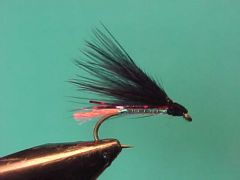
{{+1}}Cormorant – black attractor variant{{-1}}
{{start}}
This is my favourite attractor version of a cormorant for loch style fishing in waters where trout are switched onto black flies.{{end}}
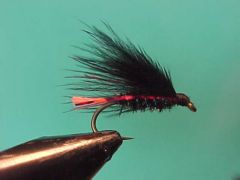
{{+1}}Cormorant – variant to the original tie{{-1}}
{{start}}
I carry black and olive versions of this fly. A simple to tie fly that incorporates two of the greatest fly tying materials, marabou and peacock herl and it continues to be a popular single or team fly. It's also a fly that has lent itself to adaptation and you will often come across versions with glass or brass bead heads, bodies of all sorts of tinsels and colours and wings in a range of marabou colours. These days the cormorant and its many variations are fished in all sorts of ways from almost static right up to roly poly on a full range of fly lines.{{end}}
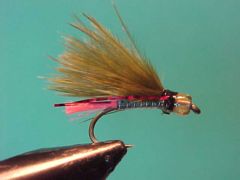
{{+1}}Cormorant – BH competition version{{-1}}
{{start}}
The cormorant fly is a popular loch fly and particularly in rainbow trout waters. The original tie has a peacock herl body with silver rib whereas this competition version has been jazzed up a bit by substituting clear holographic tinsel for the herl body.{{end}}
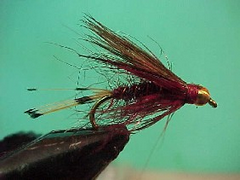
{{+1}}Bead head mallard & claret{{-1}}
{{start}}
A variation on my Soft Winged Bob flies is to turn them into anchor flies for use as the point fly in a team of loch style flies. They are attractive to fish and because of the smaller size and additional weight they sink faster than most flies and keep my leader straight making it easier to keep in contact with my dropper flies. The weigh is a 2mm gold, copper or black tungsten bead (or brass bead and 8 wraps of .015mm lead on the front half of the hook shank).{{end}}
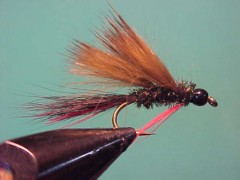
{{+1}}Bead head bag fly{{-1}}
{{start}}
I now tie it in three versions. The first is as set out in the recipe below. Originally designed for red fin feeders it has become my favourite bag fly overall. It has red hackle fibres tied under the tail and as a light beard and over time I found these a great trigger point for all versions. The second version is all brown except for the red beard and is a great alternative to a Diawl Back. Finally I tie a bead head version for when I want to fish a little deeper.{{end}}
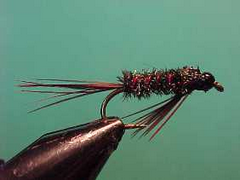
{{+1}}Bead head diawl bach{{-1}}
{{start}}
I tie it both with and without weight and find the addition of a small black tungsten bead makes it a handy anchor fly or a good prospecting fly in running water.{{end}}
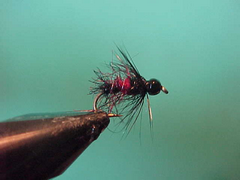
{{+1}}Bead head bibio variant{{-1}}
{{start}}
A bead head version is not a bad idea either. Swap over to a slightly longer hook such as a Tiemco 3769, start with a small black tungsten bead and continue with the recipe below. My version below varies from the original tie in that it doesn't include a body hackle. Instead the body is dubbed with seal fur dubbing which has been teased out in step 'D' with a Velcro rub.{{end}}













